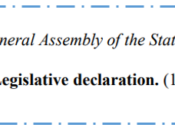by Asia Merrill
Drafters of statute have the difficult task of turning complicated ideas into plain and clear legislation. They work closely with legislators to translate the legislators’ ideas into laws that avoid the need for complex interpretation. The intent of the General Assembly must be as clear as possible so that the law can be administered or followed in the manner that the General Assembly intends. If a statute is interpreted by the Colorado courts, then between precedent and the statute itself, everyone should receive a just and consistent interpretation. Despite this, when several interpretations of a law do arise, lawyers and judges may turn to legislative declarations and statements of intent if they are included in the bill that enacted the law in dispute to help interpret the statute.
Most of the time when legislators decide to include a legislative declaration or a legislative statement of intent, they choose legislative declarations. Per the Colorado Legislative Drafting Manual, legislative declarations are a formal announcement about a bill. They can establish a philosophical reason behind the new statute or deliver context or history regarding the fiscal or social issue driving the law. In general, they encapsulate the “why” and sometimes the “how” of the proposed legislation. Legislative declarations may also provide data and findings by the General Assembly to support the legislature’s claims and associated actions.
Legislators may choose between nonstatutory or statutory legislative declarations. Both hold the same legal weight, but each serves a different organizational purpose. Usually, if a bill creates a new entire part or article or it only creates a new section, a statutory legislative declaration is the obvious choice. It’s a way to attach the declaration to the language itself in the statute books, where attorneys and citizencan most easily access it. If a drafter creates or amends multiple areas of statute, however, a nonstatutory legislative declaration most effectively gives context to the language without repeating the declaration in each new or amended section. Nonstatutory legislative declarations are only shown in the Session Laws, but they are cross-referenced in editor’s notes after a statute in the Colorado Revised Statutes.
Legislators will also use a statement of legislative intent, which describes the intended purpose and desired effect of a bill. In general, legislative intents focus on what the outcome of the bill should be. Statements of intent should never be necessary to understand the desired outcome of the statute and should only supplement the bill. A relatively simple example of a statement of legislative intent is section 6-1-401, C.R.S., which establishes that the entire part is intended to:
[Assure] that assistive technology [is] provided to persons with disabilities, is of quality, and is covered by adequate warranties to maintain their assistive technology in proper working condition; to assure availability of appropriate loaner replacement assistive technology while their own is being repaired; and to encourage manufacturers and dealers to cooperatively pool assistive technology resources for loaner purposes to assure availability without an undue burden.
While short and sweet, the statement acts to announce the people the law is intended to serve and simply establishes the desired outcome.
Legislators should use neither declarations nor statements of intent to simply garner support for a bill, although that certainly seems to happen from time to time. On the other hand, legislators should exercise caution when putting too much weight into a legislative declaration or a legislative statement of intent, lest the underlying statute may fail to address the problems they are trying to solve. It goes without saying that a legislator, and in turn, a drafter, should never use a legislative declaration to replace clear, concise statute.

